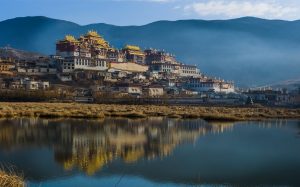Shangri-La Rises From the Ashes

China: Postal Savings Spreads the Love 26 Ways
1 October, 2016
An Alternative Way to Make Money
1 October, 2016AFR Sophisticated Traveller, October 2016
Below is the text as filed. To see the article as it ran, click here
Back in 1933, the British author James Hilton published the novel Lost Horizons, and introduced a whole new word and idea into our consciousness: Shangri-La.
In the book, four people on a hijacked plane find themselves stranded in an ethereal and isolated settlement in a Himalayan valley, where mysterious people in a monastery live to be 200 years old without appearing to age. Shangri-La was the name of this mythical place, later picked up and used by the Hong Kong-based hotel chain in 1971, and it entered the popular imagination as a generic term for a certain kind of place: peaceful, beautiful, idyllic. And fictional.
Not any more. In the late 1990s, the government of Yunnan calculated that the southwestern Chinese province corresponded with the topography and location described in the book, and laid claim to being the place Hilton was referring to all that time ago. And so the quiet city of Zhongdian – or Gyaitang, to its Tibetan population – was renamed Shangri-La in December 2001. These days, you can fly there.
It was, of course, a tourist grab, but it was not unsuccessful. China characteristically put in the infrastructure to support it, such as an airport festooned with vivid Tibetan artistry on the walls and circular mandalas in the ceilings, and hoisted the world’s biggest prayer wheel up a hill and in to the monastery in the Old Town. And, steadily, people began to come, adding the town and its beautiful surroundings to itineraries that had typically stopped at the traveller towns of Dali and Lizhang and the Tiger Leaping Gorge further south. Soon 500,000 people a year were coming.
It grew, and it grew; and then, in January 2014, Shangri-La caught fire.
The old town, which the Tibetans know as Dukezong and have settled for about 1,100 years, had been the heart of the tourist experience. Built entirely with wood from the surrounding forests, with prayer flags above and cobbled streets below, it was an evocative place to drift and get lost. But the pace of tourist development over the previous 15 years had become ramshackle and unchecked with shops, bars and restaurants on top of each other. When the fire went up, the weather had been dry, the wood and the terraced buildings provided fuel, and the water that could have put it out was frozen solid. Nobody died, but most of the town – probably three quarters – was razed.
Today, rebuilding is well-advanced, and the tourists are being coaxed back. They’re expecting a great summer season. But is it really Shangri-La, a place to enjoy the serenity the word is now intended to evoke? If you go, will you – as the hotel slogan has it – find your Shangri-La?
